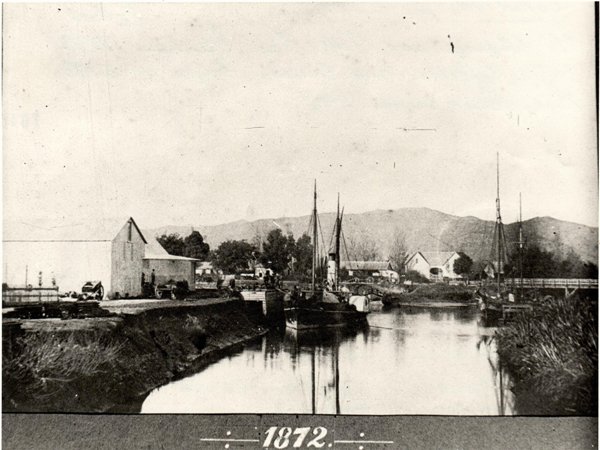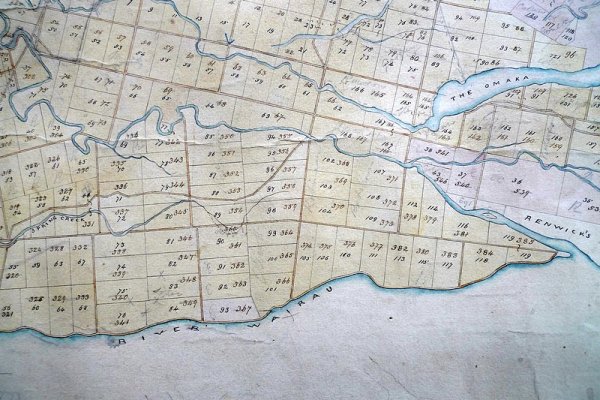Blenheim, or The Beaver
The Wairau Affray in 1843 badly frightened potential European settlers and it was to be several more years before they again began to consider the potential of the wide plains, and the area where Blenheim now lies.
The Wairau Affray in 1843 badly frightened potential European settlers of the Wairau and it was to be several more years before the Nelson settlers again began to consider the potential of the wide plains.
In 1845 some hardy Nelson settlers returned and were very impressed with the suitability of the Wairau for settlement. By 1847, a few European settlers had trickled across from Nelson and become involved in pastoral pursuits.1
James Wynen was the region's first shopkeeper. With his brother William, he set up a highly lucrative business in 1847 at the entrance of the Wairau Bar.2 Their virtual monopoly included shipping and receiving goods,3 a store, accommodation house and drinking shanty. Boats from Wellington and Nelson moored outside the Wairau River mouth, not wanting to cross the Bar. Cargo was discharged into Wynen's whale boats and taken up the river to be stored at his large raupo warehouse located on the banks of the Omaka River, which he eventually converted into a shop.4
In 1852, a rival arrived and set up shop nearby. Scotsman James Sinclair was to become one of the most influential men in the Wairau and became known as the King of the Beaver.5 He was the principal land agent in the area, owned a store and a hotel and acted as banker and merchant to the pastoral runholders.6
The early settlement, located at the junction of the Omaka, now known as Taylor, and Opawa Rivers was dubbed The Beaver, Beaver Town or Beaverton because of frequent floods. At first, buildings were clustered around the two stores and two hotels of James Wynen and James Sinclair. The fledgling township, located in what is now lower High Street7 also had a blacksmith, wheelwright and shoemaker, supplying the basic needs of the European settlers.8
Blenheim's earliest Europeans were very isolated with no roads, fences or bridges and mail just twice a month. Bullock teams would camp on the banks of the Wairau or Waihopai Rivers waiting for the high waters to subside. It was a day's journey to Waitohi (now Picton), with horses swimming across the Wairau and people following in canoes.9
The earliest days of The Beaver were also known for their informality and friendliness. ".....then the little community was simply like one large family, entering readily into each other's joys and sorrows.....There were no luxuries, but a plentiful supply of substantial necessaries..." wrote T.L Buick in Old Marlborough.10
In 1857, Dr Stephen Muller arrived from Nelson as resident magistrate and postmaster.11 By this time, The Beaver had a Court House, Post Office and plans for a Customs House. One hundred coastal vessels sailed up the river in 1857, and took away 2,288 bales of wool to the value of £51,450.12
The settlers in Waitohi had nurtured hopes of the town becoming the provincial port, if not its capital. In 1849, Governor George Grey had promised that a road linking Waitohi to the Wairau would be constructed and the township would become the Wairau district's port. However, the rapid rise of The Beaver and its river port saw bitter rivalry between the two towns throughout the provincial government years.13 Picton remained the provincial capital until 1866, when it changed to Blenheim.14
Blenheim and Picton formally gained their names when the Wairau was gazetted as the new province of Marlborough in 1859. The Beaver locals had tired of the jokes about floods and beavers and dams, and urged the Government of the day to change the town's name to something more dignified.15
[2009. Updated Dec. 2020]
Permission should be sought from the Marlborough Museum prior to any reuse of these images.
Story by: Joy Stephens
Sources
- Buick, T.L. (1900, 1976) Old Marlborough Palmerston North, NZ: Hart and Keeling. Reprint published by Capper Press, Christchurch. p 317- 319.
- McIntosh, A.D. (1940, 1977) Marlborough: A Provincial History. Whitcombe &Tombs Ltd, NZ, Australia, London. Reprint published by Capper Press, p 155.
- Buick, p. 331.
- MacDonald, C.A. (1940?) Pages from the Past: Some Chapters in the History of Marlborough. H. Duckworth, Blenheim, NZ, Printed by Whitcombe and Tombs Ltd, p 199, 258-260
- McIntosh, p. 157
- MacDonald, p. 261
- McIntosh, A.D. p 170
- Buick, p. 350-351
- MacDonald, C.A. p 266
- Buick, T.L., p367
- MacDonald, C.A. p 264
- McIntosh, A.D. p 191
- McIntosh, A.D. p 186- 192
- Marlborough Province and Provincial District (2007) from An Encyclopaedia of New Zealand, edited by A. H. McLintock, originally published in 1966. Te Ara - The Encyclopedia of New Zealand
https://teara.govt.nz/en/1966/marlborough-province-and-provincial-district - MacDonald, C.A. p 266
Further Sources
Books
- Beverley, A. (1969) The First Hundred Borough of Blenheim 1869-1969. Blenheim (N.Z.). Borough Council
http://www.worldcat.org/oclc/112792 - Buick, T.L. (1900, 1976) Old Marlborough Palmerston North, NZ: Hart and Keeling
http://www.worldcat.org/oclc/7342837 - Elvey, W.J. (1957) Kei puta te Wairau: a History of Marlborough in Maori Times. Christchurch : Whitcombe and Tombs
http://www.worldcat.org/oclc/8367081 - Holdaway, B. (2016) The Wairau and its forgotten capital. Blenheim: Barry Holdaway
- Kelly, H.D.(1976) As high as the hills: the centennial history of Picton Whatamongo Bay, N.Z. : Cape Catley Ltd. for the Picton Borough Council
http://www.worldcat.org/oclc/3241095 - MacDonald, C.A. (2003) Pages from the Past: Some Chapters in the History of Marlborough (2nd.ed) Christchurch [N.Z.] : Cadsonbury Publications
http://www.worldcat.org/oclc/155888582 - McIntosh, A.D. (1977) Marlborough: A Provincial History. Christchurch, N.Z.: Capper Press
http://www.worldcat.org/oclc/154763562
Newspapers
- Andrews, J. (1985) Some glimpses of history along the Tua Marina - Picton Road. Journal of the Nelson and Marlborough Historical Societies, 1(5), p.23-24
http://www.nzetc.org/tm/scholarly/tei-NHSJ04_05-t1-body1-d4.html - Andrews, J. (1989) Marlborough river transport of bygone days and some of the colourful operators Journal of the Nelson and Marlborough Historical Societies.2(3),p.13-20
http://www.nzetc.org/tm/scholarly/tei-NHSJ05_03-t1-body1-d3.html - Denton, R.T/(1982) Tewkesbury. Journal of the Nelson and Marlborough Historical Societies, 1(2), p.10
http://www.nzetc.org/tm/scholarly/tei-NHSJ04_02-t1-body1-d3.html - Farnell, N. (2000) Blenheim's Cob Cottage New Zealand Legacy, 12(2), p.18
- Fulton. J. (1988) Sixty years ago : recollections of an old settler Journal of the Nelson and Marlborough Historical Societies,2(2), p.21-23
http://www.nzetc.org/tm/scholarly/tei-NHSJ05_02-t1-body1-d5.html - Gray, M. (2006, July 14) My town Blenheim. New Zealand Woman's Weekly, p.30-31
- Hindmarsh, G. (2006, Spring) Whales, war & wine. Heritage New Zealand, p.30-35
- Holdaway, B. (1995) Some Christmas thoughts on the siting of Blenheim Marlborough's Past & Present.3, p.18-20
- Kerr, L. (1996) Taylor Ford township - where man and river meet Marlborough's Past & Present, 1996; n.5:p.2-5
- Kerr, L. (2000) Picton -- port of entry to the South Island : a photographic essay New Zealand Memories, n.25:p.62-63
- Leov, B. (1995) Early central Blenheim morning Marlborough's Past & Present,n.2, p.18
- Marlborough's first years (1971) New Zealand's Heritage: the making of a nation, v.2. Sydney: Paul Hamlyn, pp. 635-640
- Neill, J. (1980) The road that had no name Journal of the New Zealand Federation of Historical Societies,1(10), p.47-50
- Petman, E.&G (1993) Letters from Blenheim : 1890 Historical Review,41(2),p.94-107
- Pryce, M.H. (1977) Picton - a short history New Zealand Marine News,27(4) p.142-145
- Spanning the Wairau Marlborough's Past & Present, 1996, 4, p.22
Websites
- The borough seal (1877, July 14) Marlborough Express, 12 (936)
https://paperspast.natlib.govt.nz/newspapers/MEX18770714.2.14.1 - Cyclopedia of New Zealand: Vol. 5 Nelson, Marlborough and Westland Provincial Districts (1906) Christchurch, N.Z. : The Cyclopedia Ltd.
http://www.nzetc.org/tm/scholarly/tei-Cyc05Cycl.html - A glance at the Province of Marlborough (1859, November 30) Nelson Examiner and New Zealand Chronicle, p.3
https://paperspast.natlib.govt.nz/newspapers/NENZC18591130.2.10 - Eileen McSaveney, 'Floods', Te Ara - the Encyclopedia of New Zealand (accessed 23 December 2020)
http://www.TeAra.govt.nz/en/floods - Marlborough Province and Provincial District (2007) from An Encyclopaedia of New Zealand, edited by A. H. McLintock, originally published in 1966.Te Ara - The Encyclopedia of New Zealand
https://teara.govt.nz/en/1966/marlborough-province-and-provincial-district - Malcolm McKinnon, 'Marlborough places - Blenheim', Te Ara - the Encyclopedia of New Zealand (accessed 23 December 2020)
http://www.TeAra.govt.nz/en/map/31851/blenheim
 James Wynen, Marlborough Historical Society - Marlborough Museum Archives
James Wynen, Marlborough Historical Society - Marlborough Museum Archives Blenheim's early river port, 1872, Marlborough Historical Society - Marlborough Museum Archives, 0000.900.0631
Blenheim's early river port, 1872, Marlborough Historical Society - Marlborough Museum Archives, 0000.900.0631 First courthouse and post office, 1866, Marlborough Historical Society - Marlborough Museum Archives, 19950150073
First courthouse and post office, 1866, Marlborough Historical Society - Marlborough Museum Archives, 19950150073 James Sinclair, Marlborough Historical Society - Marlborough Museum Archives, 0001
James Sinclair, Marlborough Historical Society - Marlborough Museum Archives, 0001 Plan of blocks and holdings on the south side of the Wairau River. Marlborough Historical Society - Marlborough Museum Archives. Click image to enlarge
Plan of blocks and holdings on the south side of the Wairau River. Marlborough Historical Society - Marlborough Museum Archives. Click image to enlarge Plan of blocks and holdings on the south side of the Wairau River, Marlborough Historical Society - Marlborough Museum Archives.
Plan of blocks and holdings on the south side of the Wairau River, Marlborough Historical Society - Marlborough Museum Archives. Plan of blocks and holdings on the south side of the Wairau River. Marlborough Historical Society - Marlborough Museum Archives. Click image to enlarge
Plan of blocks and holdings on the south side of the Wairau River. Marlborough Historical Society - Marlborough Museum Archives. Click image to enlarge